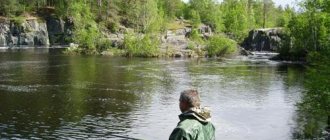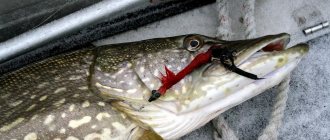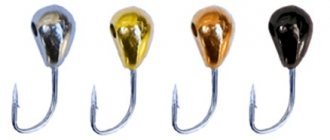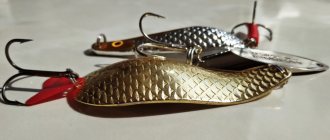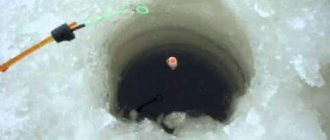Methods for catching ide from ice
One of the most effective ways of catching ide in winter is fishing with a jig. When catching this fish in this way, you must follow some rules. When biting, the ide often swallows the bait along with the hook, so it should be hooked after some time (2-3 seconds). When fishing for an ide, you should not loosen the line; you need to let the fish become exhausted, and then smoothly lift the ide to the surface.
Read! Catching perch in winter with a Koza reelless reel
The color of the jig should depend on weather conditions. So, when catching this fish in clear, sunny weather, tackle of copper and brass colors is best suited, and on cloudy days - silver-colored jigs.
When catching ide with a jig, you should make smooth oscillations of the bait at the bottom, periodically raising and lowering the tackle.
When fishing for ide using a trolling method, the fish bite is clearly felt, so instead of a nod, it is best to take a hard whip. The thickness of the fishing line should be taken in the range from 0.14 to 0.22 mm, depending on the size of the intended prey.
Small vertical spoons, the color of which depends on the depth, are used as bait. Bronze and copper-colored tackle are best used in the shallows, while polished spoons work well in deeper areas. In order for the spoon to imitate the movement of live fish as much as possible, it must first be smoothly lifted from the bottom and then sharply lowered. When the spoon sinks to the bottom, you need to make several pendulum movements.
In winter, catching ide on a balancer gives good results. The technique of fishing with this tackle is almost the same as the technique of fishing with a spinner.
Where to catch ide in winter
Finding ide in winter is no more difficult than finding other fish, or rather, that’s where you need to look. Ide almost always stays among perch or bream. If a winter resting place for bream or perch is found, and ide is also found in the reservoir, then the likelihood that ide will be found in the catch is very high. Just to catch an ide, you need to know that the ide always stays above other fish, usually half a meter above the bottom, but it is better to fish all layers of water, because the ide can rise higher.
When the frosts subside and there is good, warm winter weather, the ide can go into shallow water, where there is a lot of food for it - small fish. Very often, ide can be found at a depth of less than a meter, very close to the shore.
Ide loves to stay among flooded snags. Fishing in such places is dangerous on hooks, but if you step back a little from the snags and fish in close proximity to them, but at a safe distance, then the ide catch will be large.
Experienced fishermen often arrange winter camps for ide while still in open water, flooding snags in the intended winter fishing spot. To prevent driftwood from being carried away by the current, a heavy load or just stones from the shore are tied to them. In any case, such a place will be favored by fish in winter and the catches will contain not only ide, but also other fish, both predatory and peaceful.
The locations of ide in winter are easy to figure out if you know the preferences of bream. Ide also avoids strong currents and prefers a muddy-sandy bottom with sharp changes in depth.
We fish in winter. Beyond the river
Yazi can be active at different times of the year, so winter is not a hindrance for him. The main thing is to know when you can catch it, where and with what. We'll tell you how you can catch ides in rivers in winter.
The most favorable time for fishing ides in winter is considered to be the beginning of winter, according to the first ice, and the end of the winter season, according to the last ice. Fishing is also good during thaws. But in severe frosts, ide, on the contrary, is not caught because it lies on the bottom. But, with the onset of a thaw, fish quite often come out to shallow sections of rivers. Usually it stands at depths of 5-2 meters, near riffles, trees or lowlands fallen into the water. From such places she periodically comes out to look for food near the river currents.
If the oxygen regime in the reservoir is at a good level, the water is constantly enriched with oxygen from streams, springs, springs or small rivers, then ides come out to look for food at their mouths not only in the spring season, but also in the middle of winter. This especially happens with the onset of warm days with low atmospheric pressure. We caught ides on favorable days and in snags where perches are usually found. If we talk about the depths of fishing, then ides can be unpredictable. And this fact applies not only in summer, but also in winter. They search for fish by fishing all horizons of the water column, and the trophy can be bitten either at the bottom or in middle waters, as well as at the very surface under the ice.
Read: Ice fishing in the Arkhangelsk region
The best times of day for catching ide are considered to be evening, morning and night. They fish on a winter fishing rod with a jig, placing a piece of fish, small worms, maggots or bloodworms on its hook. Medium black jigs with bright splashes are considered the optimal catchable baits. Some anglers also catch ide with light-colored perch spinners. Other anglers have adapted to fishing with live bait using poles. In this gear, it is best to use minnows or bleak as live bait.
It is best to use bait at the end or beginning of winter. At this time, it can bring good results. It is easy to prepare, for which bloodworms and egg whites are added to the base of plant ingredients. The tactics for using such bait are simple. Having caught a random ide, a little bait is thrown into the hole. After some time, a flock of his relatives should run to this place.
After the fish bites, you must make a hook, and it should be done carefully, just like when you fish out an ide. Knowing that fish are less active on the hook in winter, there is no need to relax. After hooking, yazzies can make quite strong maneuvers and jerks, for which you need to be prepared. But the fish does not resist for a long time, as it gets tired, which the fisherman must quickly take advantage of and pull the trophy onto the ice.
Read: Fishing on first ice. Subtleties and nuances
Ise are often caught together with other fish that are nearby. This can be either roach or perch, and you can also focus on the bite of dace, which, together with ide, lead a similar lifestyle in winter. Happy ide fishing!
Winter baits for ide
Success in winter ide fishing is determined by the correct choice of bait. These can be not only artificial jigs and spinners, but also natural food items. Some of them have earned popularity among experienced fishermen.
- Good baits for catching ide in winter are reelless jigs. In the right hands, various devils, goats, small fish and nymphs can bring not only small roaches, but also trophy fish.
- Of the metal spinners, the most promising are perch models with a width of 6-8 mm and a length of 25-28 mm.
- The ide bites on the balancers much less often. However, if a small bait has a good action with skillful retrieving, then there is a chance of getting a redfin fish onto the ice.
- For fishing with baits such as bloodworms, maggots, and burdock larva, attached jigs are used. They come in different sizes, weights, colors, and also differ in behavior under water. To choose an attractive model, you need to take into account the bottom features, fishing depth, weather conditions, etc.
- As for natural baits, ide loves bloodworms, worms, and maggots. In winter, fish can be capricious, so a necessary condition for ice fishing is the use of bait made from protein components with the addition of small bloodworms. Effectively lures ide to the fishing point by attaching it for 2-3 days. To do this, various food components are lowered into a hole in mesh feeder models. It is this structure that helps the bait wash out more slowly.
Bait game
The ide bite usually occurs at the moment the second artificial bait lifts off the bottom and after a couple of seconds of “trembling”.
Jerks must be done sharply with a rise to a height of about 9-12 cm, with pauses of 3-6 seconds, and raised to a height of up to half a meter. The amplitude of the oscillations is small and depends on the speed of the current and the depth of the fishing. In our case, the oscillation frequency is in the range of 90-110 per minute.
The disadvantage of tandem fishing is that if, after biting and hooking, a large fish rushes to the side, the second hook can get caught on any obstacle, and this threatens the loss of not only your catch, but also the bait. The ring release will help you get rid of snags, and the hook will help you pull the fish out of the hole.
What to catch ide in winter
Natural baits for catching ide in winter. Since in winter ide is usually just an addition to catching perch or bream, baits that are more suitable for other types of fish are used. To catch ide in winter, it is best to use baits of animal origin, although ide is also caught well on dough in winter. Best to use:
- bloodworm;
- maggot;
- worm;
- burdock moth larva;
- bark beetle
The ide is also excellent for catching with live bait, but the roach is very difficult to catch with live bait. Therefore, live bait is more often used when fishing for ide in winter on large rivers, where this fish reaches a respectable size. On small bodies of water it is better to use more modest bait.
You should know that ide will never bite on ruff, perch or goby. The best live bait for catching ide in winter is crucian carp, rudd, perch, bitterling, and roach.
Typically, ide is caught at a higher level than other fish, so purposeful fishing for ide usually involves abandoning other fish. When fishing from the bottom, you practically lose the opportunity to catch an ide, and when fishing in the middle layers, there will be no bites from other fish, which usually stand at the bottom.
Artificial bait for ide in winter. To catch ide in winter, you can successfully use both jigs and winter spinners. They catch ide in winter using the following baits:
- perch spoon;
- reelless jig;
- jig;
- balance.
I’ll say right away that a balancer is the worst option for catching ide in winter. It is extremely rare to catch ide on this bait, although perhaps the ide bite will be quite good on some models of balancers.
Ide is caught very well with small spoons, approximately the same ones used for catching perch. The spoon should be no more than 3 cm long and up to 1 cm wide. The ide has a small mouth, so it is important not to overdo it with the size of the bait.
The ide also goes well with a jig, but it is best to use a jig with bloodworms or maggots added. In order to increase the attention of the ide to your jig, you can hang a small colored cambric or even several different colors on it. Such a play of colors can attract the attention of an ide better than a regular jig.
You can use jigs of any shape and experiment. But such jigs definitely show good results:
- Uralka;
- ant;
- devil.
If the ide doesn't bite . Since winter fishing is often unpredictable, the ide may refuse to bite at all. To activate its bite you need to use bait. A regular feed maggot is suitable for this. You need to feed very little, literally half a meal, so as not to overfeed the fish, which in winter eats much less and gorges on even a small amount of food. It is best to mix breadcrumbs with the bloodworms, then the effect of the bait will increase significantly. So, by adding a little bait into the hole, you can keep the fish in the fishing spot and stabilize the bite.
Catching ide with a winter float rod
The length of the winter float rod does not play a special role. The main equipment differs from the nodding fishing rod by the presence of a float. When fishing with a hook, bait and vegetable baits are used. Ide is well attracted by “sandwiches” of bait and attachments in different combinations. Bloodworms, maggots and worms available during the cold season are used. The attachments are peas, steamed wheat, specially prepared semolina and dough. Carp boilies should not be ignored either. The use of jigs increases the efficiency of fishing.
When fishing with a float rod in winter, you need to use bait. The bait is fixed above the bottom surface. You can start with 30 cm, and if there is no bite, perform a slight rise.
The gear is positioned so that the floats are in sight. There is no need to abuse the amount of gear. 2-3 gear is enough. After all, you shouldn’t exclude passing bites from other fish species.
